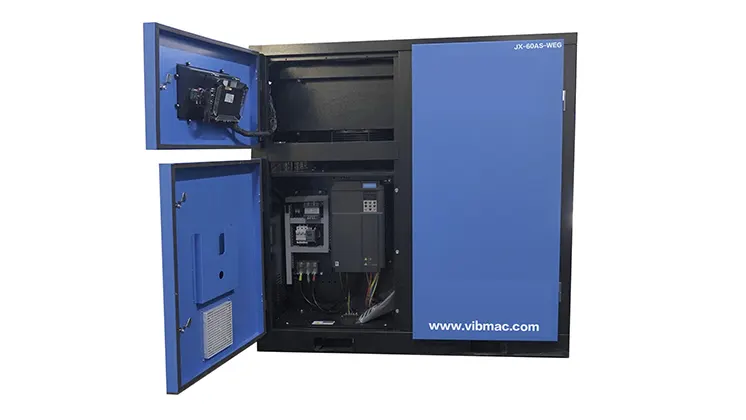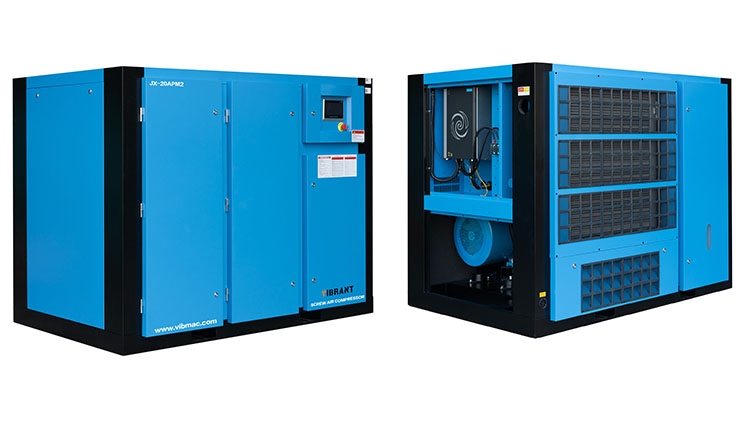
For a chemical production company that wants to operate stably and normally, it must have compressed air which is one of the indispensable utility projects to escort it. A chemical company, with the passage of time, upgrades the transformation of the plant, energy consumption, environmental protection and other aspects of the requirements. The original piston compressor in the plant was upgraded to a rotary screw air compressor, which greatly improves the efficiency of air production, reduces operating costs and is easy to operate. This paper focuses on the use, maintenance and daily operation of rotary screw air compressors (hereinafter referred to as “air compressors”) in the plant.
1. The principle of operation of the air compressor
M315AC screw air compressor is an oil-injected single-stage screw compressor in the chemical company, the negative and positive rotors (or screws) in the compressor shell meshing parallel to each other rotate in the cylinder, resulting in the gas between the teeth of the rotor grooves constantly produces a cyclical volume change, and the air is pushed along the axis of the rotor from the inhalation side to the discharge side. The working mode of the air compressor is generally full pressure operation, press the start control button, wait for 2 s after the pressure drops, the rotary screw air compressor will start normal loading operation, and the pressure of the system will start to increase gradually. As the operating environment of the air compressor is in the factory, the inhaled air contains moisture, dust, impurities and so on. So the process of air intake is as follows: the air passes through the air filter to filter the dust and impurities; passes through the load reducing valve , air end, check valve, and then passes through the oil and gas separator to separate the oil and gas; the compressed air passes through the cooler to reduce the temperature of the compressed air, so as to reduce the operating temperature of the equipment, and finally passes through the air-water separator to get the clean compressed air, and then finally discharges it. If the compressed air is used as instrument air, it needs to be dried by the dryer to avoid the residual moisture in the compressed air from corroding the important instrument equipment. The basic parameters of rotary screw air compressor are shown in Table 1.
| Table 1 Basic parameters of air compressor | ||||||
| Model | Power/kW | Pressure/MPa | Air volume/(m³/min) | Overall dimension/mm | Noise level 1 m/dB(A) | Weight O.D.P/kg |
| M315AC | 315 | 0.8 | 62.1 | 4450×2140×2250 | 83±3 | 7250 |
2. Daily maintenance of air compressor
After the normal operation of the air compressor, you need to regularly maintain the equipment, the maintenance must be based on the maintenance cycle provided by the manufacturer or the actual operating conditions. Before overhauling or maintenance of the air compressor, it must be shut down, cooled down, exhaust the system air, and the pressure value is set to normal pressure. Before the operation, we should carry out risk identification, and take measures to prevent and control the possible dangers in the process of inspection and maintenance. After completing the inspection, maintenance and repair work, before resuming the operation of the air compressor, we should confirm whether the components are restored in place, whether all the inspection and maintenance tools are put away, and whether the protective cover is installed in place. After starting operation, observe whether the air compressor is running normally and whether there is any abnormality in pressure and temperature. Checking program for cooling oil level: Check the cooling oil level every day, the cooling oil is located on the side of the oil separator cylinder.
Check of cooling exchanger: the water-cooled side of the cooler should be cleaned up after running for 720 h. Regular clean up; when more dirt is formed, it needs to be disassembled and cleaned up by mechanical methods; at present, the electric drill is used together with the homemade 1.5 m steel drilling flower to clean up, which has a good effect of cleaning up.
Oil filter replacement: dismantle the filter element after stopping the machine to relieve pressure, install a new filter element, and then tighten it by hand. Check the cooling oil level at the normal scale, and see if it drips after running the air compressor.
Cooling oil replacement: put the oil in the state of “warm up” when the compressor stops running, at this time, the dirt will be suspended in the oil, and the oil temperature at this moment is easier to make the oil discharge. When there is no oil coming out of the discharge port, close the discharge valve, start to inject new oil, start the compressor to see if there is any leakage. Take extra care during the discharge of hot oil and wear good personal protective equipment.
Replacement of air filter: After confirming that the compressor has stopped and relieved the pressure, remove the air filter and put in a new one.
Replacement of oil separator core: Disassemble the oil return pipe and replace the oil separator core with a new one. Keep a detailed record of each maintenance for later maintenance and fault analysis. The maintenance list of air compressor cycle is shown in Table 2.
| Table 2 List of air compressor cycle maintenance | |
| Cycle | Maintenance |
| Operation 24 h | Check in detail whether there is any leakage, abnormal noise or vibration in the whole compressor. |
| Daily inspection | Check whether the cooling oil level is in the specified scale. |
| Running for one week | Need to replace the oil filter cartridge with a new one |
| Running 30 d | Check whether the switch of high temperature protection is sensitive; check whether the exhaust temperature sensor alarms after exceeding the set temperature; check whether the cooler accumulates dust and clean it; clean the float mechanism in the water separator; clean the filter of the water inlet pipe of the water cooling unit. |
| 90 d/time | Slowly open the safety valve manually to let the air out, and make sure the valve can operate normally. |
| 80 d/time | Replace the oil filter cartridge with a new one |
| 180 d/time | Sample and analyze the coolant; clean the oil return hole screen. |
| 160 d/time | Replace new air filter element |
| Run for one year or 1,000 h | Comprehensively check the surface, welds and joints for corrosion, mechanical damage, leakage, etc. |
| Operate for 6 months or 4,000 h | Replace exhaust solenoid valve seals |
| 6 months of operation | Disassemble and lubricate main motor bearings |
| Run 1 a | Drain cooling oil for replacement; replace oil separator and oil filter cartridge |
| Run 4 a | Replace all hoses |
| Run 6 a/6,000 h | Check oil separator cartridge |
3. Air compressor troubleshooting
Since the installation of rotary screw air compressor, the post staff carefully operate, equipment management personnel focus on the analysis of existing problems, at the same time, by consulting relevant information, the rotary screw air compressor daily occurrence of faults, causes and solutions are summarized, as shown in Table 3.
| Table 3 Fault causes and troubleshooting measures for rotary screw compressors | ||
| Fault | Causes | Troubleshooting measures |
| Failure to start | Not energized or voltage is not normal; control circuit faults | Check external wiring; check and eliminate faults |
| Exhaust gas temperature is too high | Insufficient lubrication and cooling oil | Add oil to make the oil level scale in the normal range; check whether the cooling oil is clean; check whether the cooling oil system is leaking; check the temperature control valve |
| Poor cooling effect | Check whether the exhaust air is unobstructed; check whether the size of the air guide pipe is appropriate. | |
| The running ambient temperature of the air compressor is ≥46 ℃. | Increase air circulation or air conditioning to reduce the ambient temperature of the air compressor room | |
| Operating pressure is too high equipment automatically jumps off | Failure to open the isolation valve | Make sure the isolation valve is open |
| The unloading solenoid valve is not sensitive | Check the unloading solenoid valve, disassemble and clean | |
| The air pressure does not reach the rated pressure | Air consumption is too large | Check whether there is air leakage and whether the valve adjustment is reasonable |
| Setting of starting pressure is too low | Reset the starting pressure value | |
| Pressure can not be built up, can not operate normally | No power to the solenoid valve | Repair the solenoid valve or check the circuit |
| Air compressor operating pressure is low | Set running pressure too low | Make sure the air inlet valve is open; check the stepping motor; check the starting/returning pressure setting; check whether the air inlet filter is polluted. |
| Air compressor cooling oil level is low | Return oil circulation is not normal, there is a blockage | Clear blockage |
| Air reservoir can not release air to unloading pressure | Minimum pressure valve is stuck open. | Disassemble, inspect, repair or replace |
| Air compressor safety valve does not work properly | The safety valve is jammed and does not operate | Repair or replace |
| Safety valve set value is wrong | Set the rated pressure and setting value of safety valve | |
| Air compressor stops when temperature is too high | Cooling water cooling effect is not good | Check whether the cooling water temperature is up to standard, whether the water circuit is blocked; check whether there is water in the water-cooling system, remove the filter and check. |
4. Safety Precautions for Air Compressor Maintenance and Repair
Equipment maintenance must be carried out in accordance with the regulations. Do not tighten the loose bolts and oil pipes during operation. When a fault is found, the machine should be shut down to deal with it. Safety valves, pressure gauges, relay protection devices used in the device must be designated in accordance with the provisions of the professional department for regular calibration. Tools used for maintenance (especially lifting tools, equipment) must be fully inspected to determine compliance with safety requirements before use. If you want to cover the transmission gear, motor and other equipment, the internal inspection must be carried out by professionals to confirm that there is no strange matter in the cavity before adding the cover. After overhauling, debris around the equipment must be removed. After the equipment parts are removed, if it is necessary to make wooden pallets, its stability must be checked. After long-term parking of the air compressor, you should disconnect the power supply, mechanical equipment and electrical equipment should be set up conspicuous “Do not touch” “forbidden to close the gate” and other signboards.
5. Conclusion
Rotary screw air compressor is more common in the application of chemical plants, with high efficiency and low energy consumption, it is currently a more ideal air loading equipment. To make the rotary screw air compressor run in good condition, operation, inspection, maintenance and other processes should be carried out in accordance with the requirements of the company and the manufacturer.








